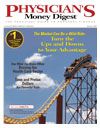Publication
Article
Physician's Money Digest
Time and Pretax Dollars Are Powerful Tools
Author(s):
A tax-deferred defined-contributionplan such as a401(k) pension and profitsharing plan can be avery powerful tool in adoctor's retirement planning arsenal.As illustrated in the table comparingretirement planning scenarios, time isan important factor in the success ofthis savings vehicle as is its applicationof pretax dollars.
Learn from a Case in Point
Dr. William Smith is a solo practitionerwho turned 39 on December 31,2006. He currently employs his spouseas his office manager, and she is his onlyemployee. Dr. Smith earned $225,000in 2006 and is considering setting up a401(k) plan in 2007. He is able to fundsuch a plan up to the maximum allowedunder current law, which is $44,000annually (all contributions are to bemade at the end of the plan year).
For the purpose of this example, letus assume the following: Dr. Smith'ssalary will keep pace with inflation,contributions to the plan will be adjustedannually for inflation, he will workto age 60, and he will live to age 90. Theinflation rate assumed will be 3% annuallycompounded over the entire timeperiod, and his net investment rate ofreturn will be 7% during both his workingand his retirement years. Furthermore,Dr. Smith will be in a 30% effectivetax bracket throughout the entireplanning time horizon. Also, we willassume that the annual costs for administeringthe 401(k) plan will be $2000annually. Lastly, if Dr. Smith choosesnot to implement the 401(k) and choosesa variable annuity instead, we willassume an additional annual charge of1% for the assets accumulating underthe umbrella of this type of vehicle.
The following three retirement planningscenarios will be compared:
- Dr. Smith implements a 401(k) plan in 2007.
- Dr. Smith waits 2 years before implementing such a plan.
- Dr. Smith does not implement a401(k) plan. Instead, he pays taxes onthe income he generates and places theafter-tax monies into a tax-deferredvehicle such as a variable annuity.
As can be observed from the tableabove, if Dr. Smith waits 2 years beforebeginning to fund a plan, this willadversely affect his pretax retirementincome by nearly $20,000 annually orby nearly $1 million on a pretax cumulativebasis over a 30-year period.
Timing Taxes Is Important
If Dr. Smith does not implement a401(k) plan and funds his retirementusing after-tax dollars deposited into avariable annuity, the result is clearlyinferior to taking the tax deductiontoday. It is true that all monies withdrawnfrom the pension are taxable,and all basis dollars going into thevariable annuity are nontaxable. Thepower of tax-deferral over a long periodof time is still going to be moreadvantageous to Dr. Smith.
However, if you have a practicewhere you employ several peoplewhose ages are close to yours, thensuch a plan would not be viable since itwould be very expensive to fund a401(k) plan for both yourself and youremployees as the IRS does not allowyou to discriminate as to who participatesin the plan.
Before you consider paying yourtaxes and investing in a variety of taxable/tax-deferred investment vehicles,always make use of the tax-deferral oncurrent income offered by the availablequalified retirement plans in the marketplace.Only after you have "maxedout"your contributions to qualifiedretirement plans should you considerother nonqualified options. Do not procrastinate.Adopt a plan and beginfunding it sooner rather than later.
Thomas R. Kosky and his partner, Harris L.Kerker, are principals of the Asset Planning,Group, Inc, in Miami, Fla. The companyspecializes in investment, retirement, andestate planning. Mr. Kosky also teaches corporatefinance in the Saturday Executive and Health CareExecutive MBA Programs at the University of Miami in CoralGables, Fla. Mr. Kosky and Mr. Kerker welcome questions orcomments at 800-953-5508, or e-mail Mr. Kosky directly atProfessorKosky@aol.com.
